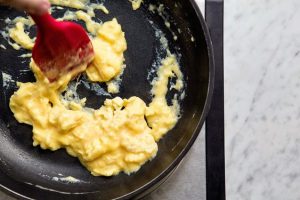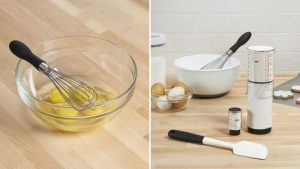The Art of Whisking Eggs
The art of whisking eggs is a fundamental culinary technique that transcends various cuisines and cooking styles. Whether you’re preparing a classic omelette, a decadent soufflé, or incorporating eggs into a myriad of dishes, mastering the art of whisking is essential for achieving the desired texture, consistency, and flavour. Whisking eggs involves more than just vigorous stirring; it’s about creating a homogenous mixture by breaking down the proteins, incorporating air, and blending the yolks and whites seamlessly.
This process not only enhances the eggs’ ability to bind ingredients but also contributes to the lightness and fluffiness of many culinary creations. Understanding the nuances of whisking eggs empowers chefs and home cooks alike to create dishes that are not only delicious but also visually appealing and texturally pleasing.
Certainly! Whisking eggs is a simple yet crucial culinary technique. Here’s how to whisk eggs:
Ingredients:
- Eggs (as many as needed)
- Bowl
- Whisk or fork
- A pinch of salt (optional)
- A dash of milk (optional for fluffier eggs)
Crack the Eggs:
- Start by cracking the desired eggs into a clean, dry bowl. You can use as few or as many eggs as your recipe requires. Also, read about eggs How to Tell if Egg is Bad: A Guide to Freshness
Season (Optional):
- If desired, add a pinch of salt to enhance the flavour of the eggs. Some people also add a small dash of milk to make the eggs fluffier, but this is optional.
Whisking:
- Using a whisk or a fork, start beating the eggs. The goal is to break the yolks and mix the yolks and whites thoroughly.
Technique:
- Hold the whisk or fork in one hand and the bowl in the other.
- Use a circular motion to beat the eggs. Start slowly, then gradually increase your speed as the eggs become more uniform in colour and texture.
- You can also change the direction of your whisking occasionally to ensure even mixing.
Consistency:
- Continue whisking until the eggs are well combined, and you can’t distinguish between the yolks and the whites. The mixture should be a consistent, pale yellow colour.
Use in Recipes:
- Your whisked eggs are now ready to be used in various recipes, such as scrambled eggs, omelettes, quiches, or as an ingredient in baking.
The Basics of Whisking
Choosing the Right Equipment
Before you embark on your egg-whisking journey, having the right tools at your disposal is crucial. Opt for a wire whisk or a fork for best results. These utensils allow for efficient mixing and aeration. Also, read about Roast vs. Bake: Unveiling the Culinary Distinctions
Preparing Your Eggs
Start with fresh, high-quality eggs. Crack them into a clean bowl, ensuring there are no shell fragments. Letting your eggs come to room temperature before whisking is also a good practice. This aids in achieving a uniform mixture.

Whisking Techniques
The Standard Whisk
The standard whisking technique involves beating eggs vigorously until the yolks and whites are thoroughly combined. This is ideal for scrambled eggs or for incorporating eggs into a batter.
The Frothy Whisk
Aim for a frothy mixture for recipes requiring extra fluffiness, such as omelettes or soufflés. Whisk the eggs briskly in a circular motion, creating tiny air bubbles for a light and airy result.
The Soft Peaks
You’ll want to whisk when making meringues or desserts like lemon mousse until soft peaks form. This means the mixture holds its shape but is still somewhat glossy.
The Stiff Peaks
For recipes like pavlova or macarons, continue whisking until stiff peaks form. The mixture will be thick, glossy, and able to stand on its own.
Tips for Success
Adding Seasonings
Remember to season your eggs with a pinch of salt and pepper before whisking. This enhances the flavour and makes for a more balanced taste.
Gradual Incorporation
When adding eggs to other ingredients, such as in a cake batter, add them gradually while whisking continuously. This prevents curdling and ensures a smooth mixture.
Patience Pays Off
Whisking eggs is a process that requires patience. Rushing can lead to overmixing or uneven results. Take your time and enjoy the process.
Troubleshooting
Dealing with Overmixing
If you’ve overmixed your eggs and they appear curdled or lumpy, don’t fret. Add a teaspoon of water and gently whisk to salvage your mixture.

Salvaging Flat Egg Whites
If your egg whites refuse to reach stiff peaks, it’s likely due to residual fat or moisture. Ensure your bowl and utensils are completely clean and dry to avoid this issue.
Conclusion
Whisking eggs is an art form that can transform your culinary creations. Whether aiming for the perfect scrambled eggs or an exquisite soufflé, mastering these techniques will elevate your cooking game.
FAQs
Can I use a regular fork for whisking eggs?
A fork is a suitable alternative to a whisk, especially for small-scale whisking tasks.
Can I store whisked eggs for later use?
It’s best to use whisked eggs immediately for optimal results, but you can refrigerate them for a short period if needed.
What’s the secret to achieving a glossy meringue?
Ensure your mixing bowl is clean and there are no traces of fat or moisture in your egg whites.
Can I whisk eggs with a hand mixer?
Yes, a hand mixer can be used for whisking eggs, especially in large quantities.
Can I add ingredients like cheese or herbs before whisking eggs?
You can add ingredients before whisking eggs to infuse flavour into your dishes.
